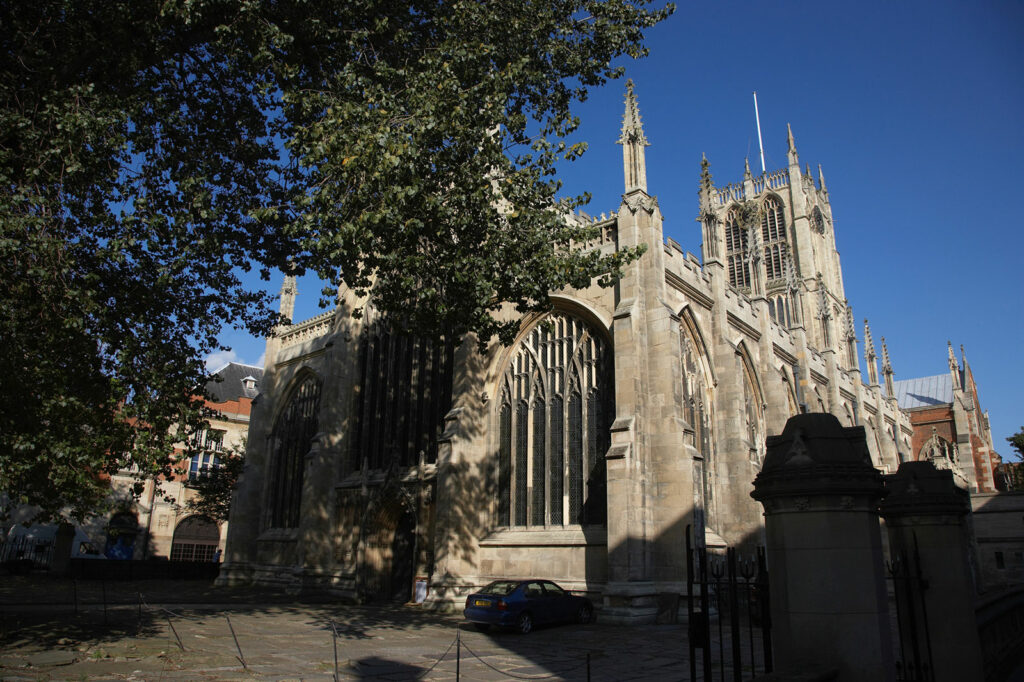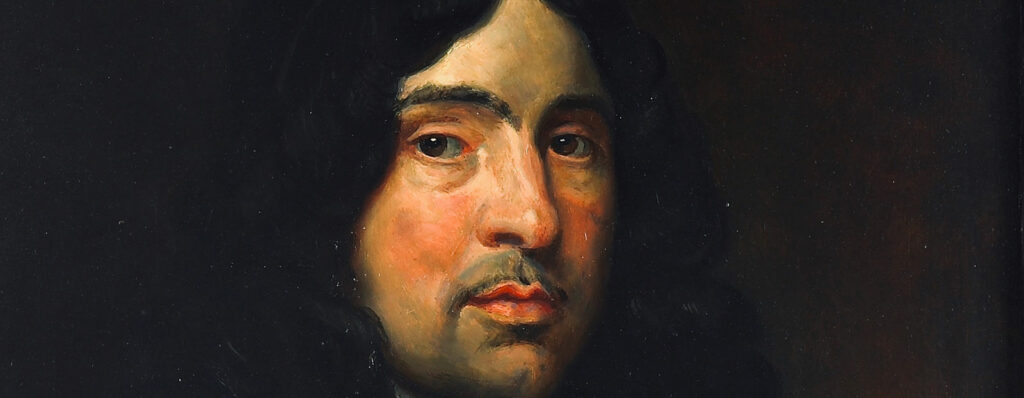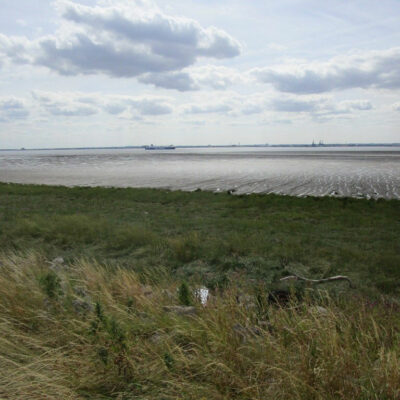Detail from Wenceslaus Hollar, Map of Hull (c. 1640). Hull History Centre, U DDMM/33/8.
Dr Stewart Mottram, Reader in English at the University of Hull, explores poet Andrew Marvell’s early life in Hull and Hull’s links to his later poetry.
Andrew Marvell (1621-78) was born on 31 March at Winestead-in-Holderness, 14 miles south east of Hull. Three years later, his family moved to Hull when his father was appointed master of Hull Charterhouse, an almshouse for the poor just north of Hull’s town walls. Marvell attended Hull Grammar School between 1629-33, leaving for Trinity College Cambridge in December 1633. His Yorkshire connections later led him to Nun Appleton, near York, where in 1650-52 he worked as tutor to the daughter of Thomas, Lord Fairfax, the former general of the New Model Army. In 1659, Marvell was elected MP for Hull, a post he held until his sudden death in August 1678 – of a fever he had contracted on a visit to Hull ‘about the Towns affaires’.[i]
In this blog, I want to explore the influence on Marvell’s poetry and prose of three key landmarks from his boyhood life in Hull – the Charterhouse, Grammar School, and Holy Trinity Church. All three appear on the map of Hull prepared by Wenceslaus Hollar in c.1640. Hollar’s map offers a unique insight into the urban appearance of Marvell’s Hull on the eve of the first English Civil War (1642-46) and the subsequent destruction of the Charterhouse in September 1643.
The Hull Charterhouse

The Charterhouse was founded in the 1350s as an almshouse for the poor. There was also a Carthusian monastery next door, but this was suppressed under Henry VIII and the priory church converted into a private house. In Marvell’s day, it was home to the Alureds, who were later connected to the Marvells by marriage. Unlike the monastery, the Charterhouse survived the Reformation and still continues to this day. The Marvells lived at the Charterhouse from 1624 until the Reverend Marvell’s death on the river Humber in January 1641.
Hollar represents the Charterhouse as a cluster of buildings in the bottom left-hand corner of his map, with the Alured’s house set slightly apart, in open fields. The medieval arched entrance to the monastery stands between the Charterhouse’s two westernmost buildings, the larger of which (closest to the town walls) was the master’s house. All these buildings were demolished during the First English Civil War in September 1643. Hull was a parliamentary town facing its second royalist siege in as many years, and its governor – Lord Ferdinando Fairfax – blew up the Charterhouse to build a gun-post on the ruins.
Few traces of Marvell’s Charterhouse survive above ground today; the present buildings were built in 1780, although parts of the master’s house date from the 1650s, and medieval brickwork forms part of the garden wall. Hull’s 1643 siege nevertheless leaves its mark on at least one of Marvell’s later poems, Upon Appleton House, to my Lord Fairfax, composed in c.1651. This poem in praise of country life, written at Nun Appleton, near York, seems a world away from Hull’s urban ruins. But a quarter of its eight hundred lines describe the ruins of Nun Appleton nunnery, and Marvell’s preoccupation with ruins may well reflect the ruin of Hull Charterhouse in 1643. Upon Appleton House also reflects Marvell’s fears that month over the threat of another royalist siege of Hull. John Shawe, the new master of the Charterhouse in the early 1650s, had celebrated Hull as a ‘Virgin Town’ for its victory over the royalists in 1643.[ii] But in August 1651, Hull faced a new threat from Scotland’s newly crowned king, Charles II, whose invasion of England had sparked fears of a royalist uprising around the city. England’s commonwealth government wrote to Fairfax at Nun Appleton on 12 August 1651, calling upon him to defend Hull, ‘of which you are now governor’.[iii]
Fairfax’s role as Hull’s new governor is marked in the poem by his appearance as ‘governor’ of Nun Appleton’s fortress-like garden, a garden that also stands in Upon Appleton House as a symbol of Fairfax’s virtuous soul.[iv] Marvell contrasts Fairfax’s virtues with the ‘virgin buildings’ of Nun Appleton nunnery: its ruin a century earlier the poem attributes to rumours of sexual scandals among its not-so-virginal nuns (l. 86: p. 219). The poem asks Fairfax to learn a lesson from Nun Appleton’s nuns. It calls on him to use moral virtues as well as military prowess to defend God’s ‘Virgin Town’ in August 1651, just as Fairfax’s father had when he was governor of Hull during the 1643 siege.
Holy Trinity Church

Holy Trinity Church (now Hull Minster). The present church, built in the 1300s, is the earliest surviving brick building in England, and England’s largest parish church. But until 1661, this cathedral-like church was officially ‘a chapel of ease’ attached to the much smaller mother church at nearby Hessle. The post of lecturer was established to allow for regular sermons to be preached at Hull when the vicar – in Marvell’s father’s day, Richard Perrot – was in Hessle.
A number of Marvell’s father’s sermons survive in manuscript; ten appear in his own hand in the unique sermon book preserved at the Hull History Centre (HHC – DIAM/1 (c. 1624-1640). This sermon book also contains a reading list and a section headed ‘Thinges to be Considered about [the] Hospitall called Gods-House’, in which Marvell Senior proposes building a ‘competent library’ above the ‘Common hall’ at Hull Charterhouse. Marvell’s father pledged his own books to this library, which he wanted to make accessible to all: ‘It will be some honour to the towne, that men may say they have a good library’, he writes. ‘I know no publike place north-ward, of which it can be so spoken’ (HHC C DIAM/1).
Several of Marvell’s poems contain suggestive echoes of images from sermons collected in his father’s sermon book, prompting questions about the whereabouts of this manuscript after 1641. The sermon book builds an image of Marvell’s father as a tolerant and open-minded churchman.[v] Alongside the sermons, it contains a medieval life of Christ, notes on Hull puritans, and even a banned heretical text, the Racovian Catechism. Marvell’s later writings in defence of religious freedoms may well have been shaped by his early exposure to his father’s eclectic religious tastes.
Hull Grammar School

The Old Grammar School that Marvell attended still stands today on South Church Side, Hull. The schoolroom, on the ground floor, measures only 20 x 70 feet. Marvell’s memories of Grammar School are recorded in two prose works from the early 1670s. Both works defend freedom of worship for Protestants outside the Church of England, in the process attacking two Anglican churchmen – Samuel Parker and Francis Turner – who had argued against such freedoms in print. Yet several of Marvell’s slurs reveal as much about his own school days as his sneering disregard for these two churchmen. What emerges from Marvell’s brief remarks is a memory of grammar school as a place of crude education and crueller violence.
Marvell’s schooldays in Hull also leave their mark on his later poetry. Among the poems he wrote at Nun Appleton, near York, in the early 1650s are two ‘to his Worthy Friend Doctor Witty’. Witty was born and educated in Beverley, near Hull, and after attending Cambridge University was appointed usher at Hull Grammar School in 1634. He left the school in 1642 to pursue a medical career, moving to York in 1651. Marvell’s poems to Witty must date from soon after his arrival at Nun Appleton in autumn 1650. They were printed in Popular Errours. Or the Errours of the People in Physick (1651), which contains a preface that Witty signs ‘From my house at Hull, Decemb. 2, 1650’ (Smith: 178). Popular Errours was Witty’s English translation of a Latin medical text by the Hull physician, James Primrose. But Marvell’s poems are less concerned with Primrose’s medical themes than Witty’s skills as a translator. Marvell’s reference to Witty as his ‘worthy friend’ implies a deep-rooted friendship that can be traced back to Witty’s time teaching Latin at Hull Grammar School in the 1630s, when Marvell was dividing his time between Cambridge and Hull. With its praise of Witty’s Latin skills, and allusions to his own role teaching modern languages to ‘Celia’ – most likely his new tutee at Nun Appleton, Mary Fairfax – Marvell’s poem in this sense reminds Witty of their shared experience as tutors.
By the tide of Humber

Written in the late 1640s, To his Coy Mistress is a witty and learned parody of Latin love poetry, the focus in 1921 for T. S. Eliot’s new appraisal of Marvell as a metaphysical poet. But the poem is also about Hull, its speaker standing ‘by the tide | Of Humber’ to lament his lover’s absence’ (II. 6-7). Marvell himself had good reason to complain to the Humber: his father drowned in the river in January 1641. Scholarship has only recently begun to relate this event to the many references to drowning in Marvell’s poetry.[vi] To his Coy Mistress also allows memories of his father’s death to wash up with the Humber tide. Like many of Marvell’s poems, it returns us to this corner of Yorkshire – to the rivers Hull and Humber, and the town built upon their shores
[i] Hull History Centre, Hull (hereafter HHC), Bench Book (1664-82), C BRB/5, p.576; cited in Nicholas von Maltzahn, An Andrew Marvell Chronology (Houndmills, 2005), p. 213.
[ii] John Shawe, Britannia rediviva (London, 1649), p.9.
[iii] Council of State to Thomas, Lord Fairfax, 12th August 1651, in Mary Anne Everett Green(ed), Calendar of State Papers, Domestic Series, 1649-1660 (13 vols, London, 1875-86), III (1877), pp.323-4 (p.324).
[iv] Andrew Marvell, ‘Upon Appleton House, To my Lord Fairfax’, in The Poems of Andrew Marvell, ed. Nigel Smith, rev. edn. (London, 2007), pp.210-41 (l. 297). Subsequent references to the poems are to this edition.
[v] See Nigel Smith, Andrew Marvell: The Chameleon (New Haven, 2010), pp.20-25.
[vi] See, for example, Nicholas von Maltzahn, ‘Death by Drowning: Marvell’s Lycidas’, Milton Studies 48 (2008), pp.38-52.




